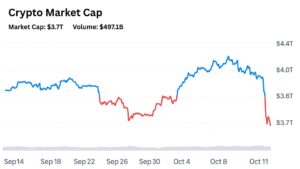The crypto market has just experienced one of its most dramatic collapses in recent history. When Trump announced aggressive tariffs in October 2025, the ensuing volatility triggered a massive crypto leverage liquidation affecting 1.6 million traders and wiping out hundreds of billions in market value. For many cryptocurrency projects, the instinctive response is to freeze marketing budgets, pause campaigns, and wait for calmer waters.
This instinct, while understandable, is fundamentally wrong.
The Anatomy of the October 2025 Crash: Understanding What Really Happened
The crypto leverage liquidation that devastated 1.6 million traders wasn’t a random market event—it was a predictable cascade triggered by geopolitical tensions. Understanding the mechanics of this crash is critical for making intelligent marketing decisions.
When Trump tariffs created October 2025 volatility, the crypto market was sitting on a powder keg of overleveraged positions. Traders using 10x, 20x, or even 100x leverage found themselves liquidated within minutes as Bitcoin dropped sharply. This wasn’t about fundamental crypto weakness—it was about external macro shocks meeting excessive leverage.
The cascade worked like this:
- Trump’s tariff announcement created immediate risk-off sentiment
- Major holders reduced exposure, triggering the first wave of price drops
- Automated liquidation engines kicked in, selling positions to cover margin calls
- Each liquidation pushed prices lower, triggering more liquidations
- Within hours, 1.6 million leveraged positions were forcibly closed
For crypto projects watching this unfold, the critical insight is this: the crash wasn’t about your technology, your team, or your vision. It was about macro fear meeting overleveraged speculation.
This distinction matters enormously for your marketing strategy.
 Why Performance Marketing During Cryptocurrency Downturns Is Your Competitive Advantage
Why Performance Marketing During Cryptocurrency Downturns Is Your Competitive Advantage
While competitors slash budgets and go dark, sophisticated projects recognize that performance marketing cryptocurrency downturn conditions create asymmetric opportunities.
Here’s the counterintuitive reality: bear markets are when performance marketing delivers its highest ROI.
Lower Acquisition Costs When Competition Disappears
Historical data from previous crypto winters shows that advertising costs can drop 40-60% during market downturns. Why? Because 90% of projects pause their campaigns simultaneously.
When the Trump tariffs October 2025 volatility hit, programmatic ad inventory suddenly flooded the market. Projects that maintained strategic ad spend saw their cost-per-click (CPC) and cost-per-acquisition (CPA) metrics improve dramatically.
Consider these dynamics:
During Bull Markets:
- High competition for ad inventory
- Inflated CPCs across all channels
- Users overwhelmed with crypto messaging
- Conversion rates suppressed by noise
During Bear Markets:
- Minimal competition for premium placements
- Depressed CPCs create efficiency opportunities
- Users actively researching, not just speculating
- Higher-quality traffic with genuine interest
Your performance marketing strategy should capitalize on these conditions, not retreat from them.
The Quality of Bear Market Users Exceeds Bull Market Speculators
When markets crash, the profile of people engaging with crypto content fundamentally changes. Gone are the get-rich-quick speculators. What remains are:
- Developers still building regardless of price
- Long-term investors looking for accumulation opportunities
- Institutional researchers conducting due diligence
- Users seeking legitimate utility, not just speculation
These are the users you actually want. They have higher lifetime value, lower churn rates, and greater engagement with your product. Bear markets naturally filter your audience—performance marketing during downturns captures this premium cohort at the lowest possible acquisition cost.
Crypto Conversion Optimization Crash: Turn Volatility Into Growth
The concept of crypto conversion optimization crash strategies might seem paradoxical. How do you optimize conversions when markets are collapsing?
The answer lies in understanding that conversion optimization isn’t about timing the market—it’s about timing human psychology.
Retargeting Strategies for Disrupted Users
The crypto leverage liquidation that wiped out 1.6 million traders created a massive pool of displaced users. These traders:
- Lost capital on overleveraged positions
- Are emotionally raw but still engaged with crypto
- Are actively seeking safer, more sustainable approaches
- Represent acquisition opportunities for spot exchanges, DeFi protocols, and educational platforms
Smart conversion optimization during this period means:
Messaging Pivots:
- From “massive gains” to “sustainable growth”
- From “leverage trading” to “spot accumulation”
- From “moon soon” to “build for the long term”
- From speculation to utility
Funnel Adjustments:
- Extended nurture sequences acknowledging market conditions
- Educational content addressing fear and uncertainty
- Social proof from projects surviving previous crashes
- Risk management tools and features highlighted
Creative Adaptation:
- Empathetic tone recognizing losses
- Transparency about market conditions
- Focus on long-term vision and fundamentals
- Community resilience messaging
These aren’t just marketing tactics—they’re strategic positioning that builds lasting brand equity.
Attribution Modeling When Everything Is Chaotic
One of the biggest challenges in performance marketing cryptocurrency downturn conditions is maintaining accurate attribution. When markets crash, user behavior becomes erratic:
- Longer consideration cycles as fear dominates
- Multiple touchpoints before conversion
- Cross-device research patterns
- Higher drop-off rates requiring multiple exposures
This is precisely when sophisticated attribution modeling becomes invaluable. Tools like Google Analytics 4 with custom event tracking, Mixpanel for behavioral cohort analysis, and Segment for unified customer data pipelines become essential infrastructure. Projects that maintain consistent ad presence during volatility can map the complete user journey and understand which channels drive eventual conversion—even if that conversion happens weeks or months later.
Multi-touch attribution during the Trump tariffs October 2025 volatility revealed surprising patterns:
- Display ads that seemed “inefficient” during crashes proved critical for later conversions
- Retargeting campaigns showed 3x higher delayed conversion rates
- Content marketing touchpoints had outsized influence on eventual purchase decisions
- Search ads captured high-intent traffic at dramatically reduced costs
Platforms like HubSpot’s attribution reporting, AppsFlyer for mobile app attribution, or Rockerbox for cross-channel measurement allow you to visualize these complex journeys. Projects that paused campaigns lost this attribution intelligence entirely. When they returned to market months later, they were blind—unable to leverage crisis-period learnings.
The Real Cost of Going Silent: What You Lose Beyond Immediate Conversions
When projects pause advertising during downturns, they don’t just sacrifice immediate conversions. They surrender strategic positioning that takes months or years to rebuild.
Brand Recall Deteriorates Exponentially
Consumer psychology research consistently shows that brand recall follows a decay curve. When you stop advertising, brand awareness doesn’t plateau—it actively degrades.
In crypto’s attention economy, this decay is accelerated. Projects that disappeared during the crash found themselves completely forgotten when markets recovered. Meanwhile, projects that maintained visibility—even with reduced budgets—preserved mindshare and captured disproportionate attention when sentiment improved.
Competitor Positioning During Your Silence
While you’re dark, your competitors aren’t necessarily frozen. The sophisticated ones recognize the opportunity.
When 90% of crypto projects paused advertising during previous bear markets, the remaining 10% captured:
- Premium ad placements at discount prices
- Thought leadership positioning in empty market
- First-mover advantage in new narrative frameworks
- Relationship building with media and influencers
By the time markets recovered, these projects had established dominance that late returners couldn’t overcome.
Organic Search Degradation
Search engine algorithms reward consistent content production and user engagement. When you pause marketing, your organic search performance suffers:
- Content publishing frequency drops
- User engagement signals weaken
- Backlink velocity slows
- Domain authority relative to competitors declines
Projects maintaining crypto conversion optimization strategies during crashes saw sustained organic traffic growth. Their SEO foundations strengthened while competitors withered.
Programmatic Buying During Extreme Volatility: Technical Execution Strategies
For projects convinced by the strategic case for maintaining marketing during downturns, the tactical question remains: how do you execute performance marketing when everything is chaos?
Real-Time Bid Adjustments Based on Volatility Metrics
Advanced media buying platforms can integrate real-time market data to adjust bidding strategies dynamically. Tools like Google Ads automated bidding strategies, The Trade Desk for programmatic display, Meta Advantage+ campaigns, and TikTok Smart Performance campaigns can be configured with custom rules based on external data feeds.
When the crypto leverage liquidation cascade was occurring, smart bid algorithms:
- Reduced bids during peak panic hours (lowest conversion probability)
- Increased bids during stabilization periods (higher quality traffic)
- Shifted budget toward long-tail keywords showing research intent
- Paused purely speculative keywords (trading signals, moon predictions)
Additionally, integrating CoinGecko API or CryptoCompare API data feeds into your bidding logic allows you to correlate market volatility with campaign performance in real-time. This level of sophistication requires programmatic infrastructure that most in-house teams lack. Media buying platforms with crypto-specific capabilities can automate these adjustments at scale.
Geographic Arbitrage: Markets React Differently to Volatility
The Trump tariffs October 2025 volatility didn’t impact all markets equally. While U.S. and Chinese crypto communities panicked, other regions showed more resilience:
- Southeast Asian markets focused on remittances and utility
- European markets maintained institutional interest
- Latin American markets viewed crypto as macro hedge
- African markets prioritized inflation protection use cases
Performance marketing cryptocurrency downturn strategies should shift geographic emphasis toward markets with more fundamental adoption drivers rather than speculative mania. Tools like SEMrush Market Explorer for geographic keyword research, SimilarWeb for traffic analysis by region, and Google Ads geographic performance reports help identify which markets remain resilient during crashes. This requires dynamic budget allocation across regions—another capability best executed through sophisticated media buying platforms.
Channel Diversification: Not All Channels Collapse Equally
During market crashes, different advertising channels show different resilience:
Channels That Remain Effective:
- Search (high-intent users still researching)
- Email (owned audience, no auction dynamics)
- Retargeting (re-engaging existing awareness)
- Educational content (addressing fear and questions)
Channels That Become Inefficient:
- Social display (engagement drops, impressions devalue)
- Influencer (credibility damaged during crashes)
- Affiliate (traffic quality deteriorates)
- Speculative keywords (attract only desperate traders)
Conversion optimization during crashes means aggressively reallocating budget toward resilient channels while maintaining minimal presence in others to preserve optionality for recovery. Supermetrics for centralizing cross-channel data, Funnel.io for marketing data automation, and Looker Studio (formerly Google Data Studio) for visualization help you make these decisions with confidence rather than guesswork.
Case Study: Projects That Thrived By Not Pausing
While specific project names change, the pattern is consistent across crypto cycles. Projects that maintained marketing during previous crashes consistently outperformed those that went dark.
DeFi Protocol That Doubled Down During COVID Crash
When COVID-19 crashed crypto markets in March 2020, one major DeFi protocol made a counterintuitive decision: increase marketing spend by 30%.
Their reasoning:
- Competitor silence created attention vacuum
- Users seeking yield in zero-rate environment
- Narrative opportunity around financial system fragility
- Technical development continuing regardless of price
Results:
- User acquisition costs dropped 55% compared to pre-crash
- Total value locked (TVL) grew 400% during the crash period
- Brand recall studies showed 3x higher awareness than competitors
- Market share gains persisted through subsequent bull market
The key insight: they didn’t market the same way during the crash. They shifted messaging from speculative yields to sustainable, safe alternatives to traditional finance. Performance marketing focused on conversion optimization with educational content addressing fear.
Exchange That Captured Liquidated Trader Migration
When another major crypto leverage liquidation event occurred in 2021, a second-tier exchange recognized the opportunity. While Tier 1 exchanges dealt with technical outages and reputation damage, this exchange:
- Aggressively marketed stability and reliability
- Offered migration bonuses from affected exchanges
- Created educational content about risk management
- Positioned as the “safe alternative” to overleveraged platforms
Their performance marketing cryptocurrency downturn strategy focused entirely on capturing displaced traders. User acquisition spiked 180% during the crash period, with retention rates exceeding pre-crash cohorts.
Building Your Crisis Marketing Playbook: Practical Implementation
If you’re convinced that pausing advertising during downturns is strategically wrong, the next question is tactical: what specifically should you do?
Pre-Crisis Preparation: Infrastructure You Need in Place
Effective crisis marketing requires infrastructure built before the crash:
Attribution Systems: Set up multi-touch attribution tracking all user journeys. When chaos hits, you need data showing which channels maintain effectiveness. Implement Segment CDP (Customer Data Platform) or mParticle to unify data streams, and configure Google Analytics 4 custom events to track micro-conversions that lead to eventual wallet connections or sign-ups.
Creative Asset Library: Develop messaging frameworks for multiple market conditions. Have empathetic, educational, long-term-focused creative ready to deploy immediately. Use tools like Canva for Teams or Figma with template libraries, and maintain a Notion or Airtable database of approved messaging by market sentiment.
Flexible Budget Allocation: Structure campaigns with ability to shift spend rapidly across geos, channels, and audience segments without manual restructuring. Google Ads scripts, Meta Automated Rules, and Zapier integrations allow budget shifts triggered by external conditions.
Programmatic Partnerships: Establish relationships with media buying platforms that can execute sophisticated strategies at scale during volatility. Platforms like StackAdapt for native advertising, Basis Technologies (formerly Centro) for omnichannel campaigns, or specialized crypto ad networks like Coinzilla or Bitmedia provide execution infrastructure most teams can’t build internally.
During-Crisis Execution: The 72-Hour Response Window
When markets crash, you have roughly 72 hours to adjust strategy before competitors start making their own moves:
Hour 0-24: Assess and Stabilize
- Pause purely speculative messaging immediately
- Assess which campaigns are still converting effectively
- Monitor competitor responses and market positioning
- Gather team for rapid strategy session
Hour 24-48: Strategic Pivot
- Launch empathetic, educational messaging
- Shift budget toward high-intent channels (search, retargeting)
- Increase content production addressing market conditions
- Begin competitor conquest campaigns targeting their silence
Hour 48-72: Aggressive Positioning
- Scale what’s working based on initial data
- Capture premium ad placements competitors abandoned
- Establish thought leadership through media engagement
- Begin retargeting campaigns for displaced users
Post-Crisis Analysis: Capturing Long-Term Learnings
After volatility subsides, sophisticated projects conduct deep performance analysis:
- Which audiences showed resilience during chaos?
- Which messaging frameworks drove conversions despite fear?
- Which channels maintained efficiency when others collapsed?
- Which competitor weaknesses can be exploited long-term?
Use Tableau or Power BI for deep-dive analysis across datasets. Amplitude for behavioral product analytics helps identify which user cohorts acquired during the crash showed superior retention. BuzzSumo reveals which content themes resonated during uncertainty, informing future crisis messaging.
These learnings become your permanent competitive advantage. Projects that pause learn nothing—they return to market blind, repeating the same strategies that failed previously.
Why This Requires Professional Media Buying Infrastructure
Reading this strategy is one thing. Executing it at scale during actual market chaos is entirely different.
The reality is that most in-house marketing teams cannot execute sophisticated performance marketing during cryptocurrency downturns effectively. They lack:
Technical Infrastructure:
- Real-time bidding algorithms responsive to volatility
- Multi-channel attribution systems tracking complex journeys
- Programmatic platforms with crypto-specific optimizations
- Geographic arbitrage capabilities across global markets
Strategic Expertise:
- Pattern recognition from previous crypto cycles
- Rapid creative development for crisis messaging
- Channel-specific optimization during abnormal conditions
- Competitor intelligence during market disruptions
Operational Bandwidth:
- 24/7 monitoring during global market events
- Simultaneous campaign management across channels
- Rapid budget reallocation based on performance data
- A/B testing at scale during compressed timeframes
This is where professional media buying platforms deliver disproportionate value. When the Trump tariffs triggered October 2025 volatility, projects with sophisticated media buying partnerships could execute crisis strategies immediately. Those relying on internal teams or generalist agencies struggled to respond effectively.
The Strategic Imperative: Marketing Is Not Optional During Downturns
The fundamental mistake crypto projects make during market crashes is treating marketing as a discretionary expense that can be paused without consequence.
Marketing is not discretionary—it’s infrastructure.
Would you shut down your servers during a DDoS attack? Would you fire your developers during a smart contract vulnerability? Would you eliminate customer support during user complaints?
Of course not. Yet pausing marketing during downturns does equivalent damage to your competitive positioning.
The projects that dominate crypto markets long-term aren’t those with the best technology or the largest token treasuries. They’re the projects that maintained visibility, captured attention, and built brand equity during the periods when competitors went silent.
Every crypto cycle proves this pattern. Every bear market creates the same opportunity. Every crash separates sophisticated operators from reactive amateurs.
The question isn’t whether you can afford to maintain performance marketing during downturns.
The question is whether you can afford not to.
Key Takeaways
The October 2025 crash was caused by external macro factors (Trump tariffs), not crypto fundamentals-your marketing response should reflect this distinction.
Crypto leverage liquidation affecting 1.6 million traders created a massive pool of displaced users seeking safer alternatives—this is your acquisition opportunity.
Performance marketing cryptocurrency downturn conditions offer 40-60% lower acquisition costs as 90% of competitors pause campaigns.
Crypto conversion optimization crash strategies focus on empathetic messaging, educational content, and long-term positioning rather than speculative appeals.
Projects that maintain advertising during downturns capture market share, brand positioning, and attribution intelligence that takes years to rebuild.
Professional media buying platforms provide the technical infrastructure, strategic expertise, and operational bandwidth required to execute sophisticated crisis marketing at scale.
The crypto market will experience many more crashes, corrections, and volatility events. Projects that recognize these moments as strategic opportunities rather than existential threats will dominate the industry long-term.
The question is simple: will your project be visible when markets recover, or will you be forgotten in the silence?



